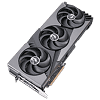 11
11
MSI GeForce RTX 5070 Ti Vanguard SOC Review
Circuit Board Analysis »Packaging
The Card
Vanguard is MSI's new GPU lineup and the cards are looking good. The color theme is still metal, with highlights in various shades of gray, but the color theme is a bit darker than Suprim—I like. On the back you get a metal backplate with a large cutout.
Dimensions of the card are 36.0 x 15.0 cm, and it weighs 1937 g.
Installation requires four slots in your system. We measured the card's width to be 66 mm.
You probably saw the slot peek out on the photo above, and wondered "maybe I can still fit a card there?" No, I've tried, even a bare card won't fit into the slot. The card is maybe 2 mm too wide.
Display connectivity includes three standard DisplayPort 2.1b and a HDMI 2.1b.
Standard for all GeForce RTX 50-series Blackwell cards is a new display engine that supports three DisplayPort 2.1b outputs, each capable of UHBR20; and one HDMI 2.1a. Both interfaces support DSC (display stream compression). With DSC enabled, a single DisplayPort on this card can drive 4K 12-bit HDR at 480 Hz; or 8K 12-bit HDR at up to 165 Hz. The RTX 5070 Ti features an updated media acceleration engine with support for 4:2:2 video formats, AV1 UHQ, and MV-HEVC. There are two independent NVENC and NVDEC units.
The card uses a single 16-pin connector, which allows a maximum power draw of 600 W, but the board power limit is set much lower of course.
Near the IO shield is the dual BIOS switch, which lets you toggle between the default Quiet BIOS and a Performance BIOS, which runs the fans at higher speed.
MSI has installed an RGB lighting zone on the "MSI" logo, near the fans and on the right side of the card on the second logo badge.
Teardown
The heatsink uses eight heatpipes and a large vapor-chamber baseplate. It provides cooling for the memory chips and VRM circuitry, too.
The backplate protects the card against damage during installation and handling.
Feb 27th, 2025 04:06 EST
change timezone
Latest GPU Drivers
New Forum Posts
- Proposal to abolish votes on the Case Mod Gallery page (6)
- getting ready for dual 5090, Functional protype on dual 4090 (71)
- What local LLM-s you use? (79)
- AAF Optimus Modded Driver For Windows 10 & Windows 11 - Only for Realtek HDAUDIO Chips (336)
- 572.42 Drivers, Screen Blacking Out? (26)
- 9800 x3d overheating what is the stock voltage (28)
- Post your Steam Game Library Categories (21)
- Nvidia's GPU market share hits 90% in Q4 2024 (gets closer to full monopoly) (663)
- WB actually did it...They closed Monolith. :( (19)
- ASRock Z370/Z390 Taichi (and some others, actively modding!) Firmware with Intel Management Engine Disabled, new method (67)
Popular Reviews
- Corsair Xeneon 34WQHD240-C Review - Pretty In White
- Corsair Virtuoso MAX Wireless Review
- ASUS GeForce RTX 5070 Ti TUF OC Review
- Gigabyte X870 Aorus Elite WiFi 7 Review
- Montech HyperFlow Silent 360 Review
- MSI GeForce RTX 5070 Ti Ventus 3X OC Review
- MSI GeForce RTX 5070 Ti Vanguard SOC Review
- AMD Ryzen 7 9800X3D Review - The Best Gaming Processor
- MSI GeForce RTX 5070 Ti Gaming Trio OC+ Review
- Montech TITAN PLA 1000 W Review
Controversial News Posts
- NVIDIA GeForce RTX 50 Cards Spotted with Missing ROPs, NVIDIA Confirms the Issue, Multiple Vendors Affected (497)
- AMD Radeon 9070 XT Rumored to Outpace RTX 5070 Ti by Almost 15% (304)
- AMD Plans Aggressive Price Competition with Radeon RX 9000 Series (274)
- AMD Radeon RX 9070 and 9070 XT Listed On Amazon - One Buyer Snags a Unit (247)
- NVIDIA Investigates GeForce RTX 50 Series "Blackwell" Black Screen and BSOD Issues (244)
- Edward Snowden Lashes Out at NVIDIA Over GeForce RTX 50 Pricing And Value (241)
- AMD Denies Radeon RX 9070 XT $899 USD Starting Price Point Rumors (239)
- AMD Mentions Sub-$700 Pricing for Radeon RX 9070 GPU Series, Looks Like NV Minus $50 Again (205)



















